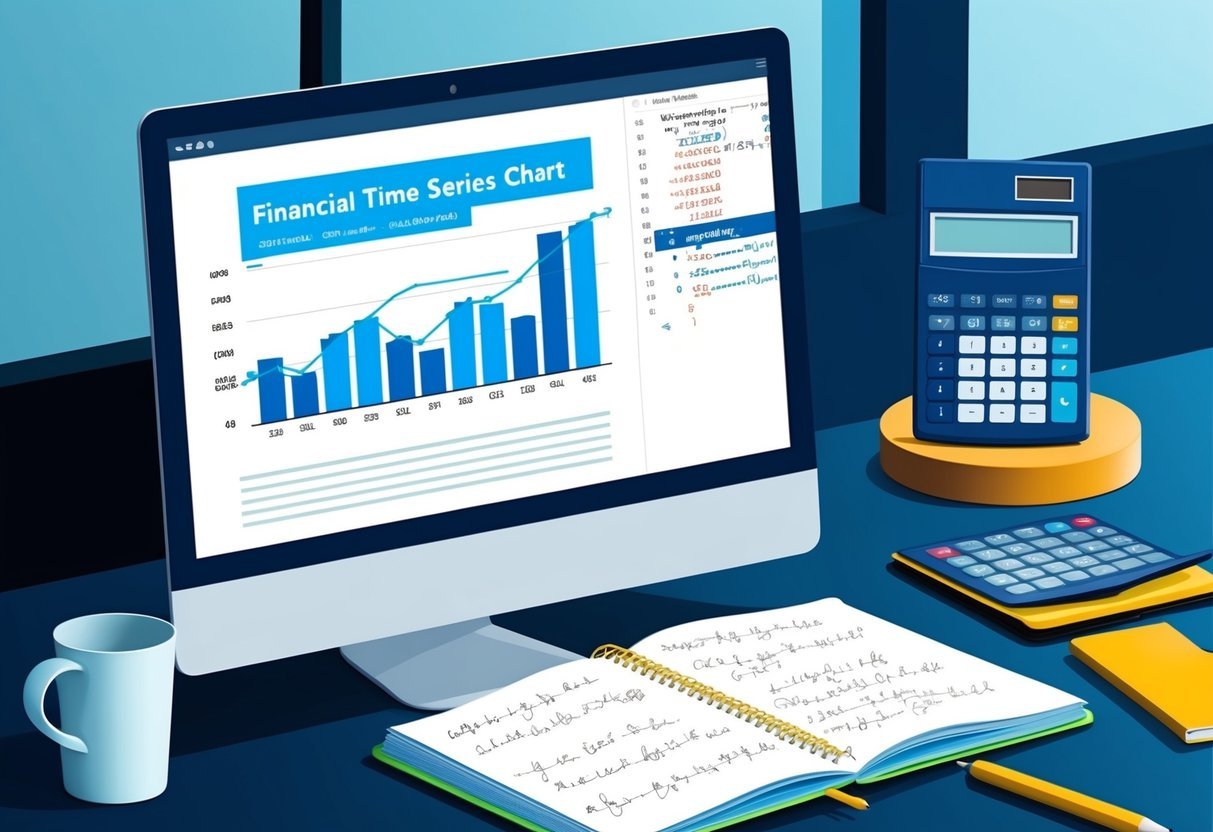Understanding Time Series Data in SQL
Time series data consists of sequences of data points collected or recorded at successive times, usually at uniform intervals.
In SQL, this type of data is stored in tables where each row represents a specific time and includes one or more metrics. This setup makes it possible to analyze trends, detect seasonality, and forecast future values.
Understanding trends and seasonality is crucial when working with time series data. A trend indicates a long-term increase or decrease in values, while seasonality shows periodic fluctuations.
SQL functions and queries can help identify these patterns by analyzing historical data, allowing analysts to detect underlying trends.
To perform time series analysis, SQL offers aggregation functions, window functions, and various date-based operations.
These tools help in breaking down data into manageable parts, computing averages, or identifying spikes. Such capabilities make SQL a powerful tool for gaining insights into time series data.
Here’s a simple table of SQL functions often used in time series analysis:
| Function | Use |
|---|---|
AVG() |
Compute the average of a metric over time |
SUM() |
Total sum of a metric over specified time periods |
ROW_NUMBER() |
Rank or order events in time series data |
DATE_TRUNC() |
Truncate date/time to particular precision |
Setting Up the SQL Environment
To start building time series forecasting models in SQL, it’s important to create appropriate time series data structures and understand the necessary SQL functions for managing time. This section will guide you through setting up these essential components.
Creating Time Series Data Structures
When working with time series data, it’s crucial to organize the data in a way that allows efficient querying and analysis.
This typically involves the use of a CREATE TABLE statement. Selecting the right data types for each column is a central consideration. For time-related data, using DATETIME or TIMESTAMP ensures accurate time representation.
Another essential aspect is defining indexes on time columns. Indexing can enhance query performance significantly when retrieving time-specific data.
Including time-stamped columns like created_at or recorded_time helps filter and sort data efficiently.
When using SQL Server, ensure that your tables are optimized for time series data by considering partitioning strategies that facilitate quick data retrieval and storage.
Defining Time-Related SQL Functions
SQL provides several powerful functions to handle date and time data effectively.
Functions like DATEADD, DATEDIFF, and DATENAME enable manipulation and calculation of date and time values. Understanding these functions helps transform and analyze time-stamped data easily.
For platforms like T-SQL in SQL Server, advanced features such as LEAD and LAG functions can be used to access previous or next rows in a dataset, vital for time series analysis.
Additionally, time zone functions are crucial if the data source involves multiple time zones.
Leveraging these tools appropriately ensures the time series model can process and predict accurately based on historical data.
SQL Techniques for Time Series Analysis

Time series analysis in SQL relies on robust techniques to manage and interpret chronological data. Focusing on data aggregation methods and specific SQL functions enhances the depth of analysis possible.
Data Aggregation and Window Functions
Data aggregation is vital for summarizing time series data, providing insights into trends over specified periods.
SQL’s window functions excel in calculating these summaries without altering the dataset structure. Using functions like SUM(), AVG(), and COUNT() over specified partitions enables users to create moving averages and cumulative totals.
Window functions allow you to define a “window” of data points for these calculations. This approach retains row-level details while providing context through aggregated views.
For instance, calculating a moving average over a monthly window helps in identifying long-term trends and smoothing out noise.
Utilizing the Lag Function for Time Series
The LAG() function in SQL is instrumental in analyzing time series data by referencing the previous row of data within a result set. This function is crucial for computing differences or growth rates over time, such as finding daily or monthly changes in data.
By specifying an offset, LAG() retrieves data from earlier periods, which is particularly useful in t-sql for tasks like calculating period-over-period changes.
Combined with other SQL techniques, such as window functions, the LAG() function provides a comprehensive view of time-related changes, supporting more detailed and nuanced analysis.
Implementing SQL-Based Moving Averages

Moving averages are key tools in time series analysis, helping to smooth data and identify trends. In SQL, both simple and exponential moving averages can be implemented to uncover patterns in data. This section explores how to compute these moving averages using SQL, offering practical guidance and examples.
Calculating Simple Moving Averages
A Simple Moving Average (SMA) calculates the average of a set number of past data points. SQL can handle SMAs using window functions, which streamline the calculation.
For example, using PostgreSQL, one might use the AVG function combined with OVER to determine the average over a specified window of data points.
Here’s an example SQL query for calculating a simple moving average:
SELECT date, value,
AVG(value) OVER (ORDER BY date ROWS BETWEEN 4 PRECEDING AND CURRENT ROW) as simple_moving_average
FROM time_series_data;
This query computes the SMA over the previous five data points, helping to smooth short-term fluctuations and highlight longer-term trends.
Applying Exponential Moving Averages
An Exponential Moving Average (EMA) gives more weight to recent data points, making it more responsive to changes. Unlike SMAs, EMAs require recursive calculations, where each previous EMA impacts the current calculation.
To implement an EMA in SQL, user-defined functions may be necessary because SQL does not natively support recursion in calculations.
Users can also break the task into iterative components in application code, computing each EMA value step by step and storing results back into the database for analysis.
EMAs are particularly useful for detecting short-term trends while maintaining sensitivity to recent changes. They prioritize recent data, which can be vital for timely decision-making in fields like finance and inventory management.
Time Series Forecasting Fundamentals

Time series forecasting plays a crucial role in predicting future data points by analyzing past trends. It involves techniques to model patterns like trends, seasonality, and cycles.
Time series data consist of observations collected sequentially over time. They are used to make predictions based on historical data. An example includes predicting sales based on past transaction data.
Forecasting models need to account for various components:
- Trend: The overall direction of the data over a long period.
- Seasonality: Regular fluctuations that occur at specific intervals.
- Noise: Random variations that cannot be explained by the model.
A common method in time series forecasting is linear regression. It’s praised for its simplicity and ability to identify relationships between variables. For deeper insights, more complex models like ARIMA or exponential smoothing are also used.
Key Steps in Time Series Forecasting:
- Data Collection: Gather historical data.
- Data Preparation: Clean and preprocess the data.
- Model Selection: Choose appropriate techniques like ARIMA or linear regression.
- Model Training: Fit the model using the data.
- Evaluation: Test the model’s accuracy.
By selecting the right model, analysts can better forecast future trends and make informed decisions.
Implementing these models in SQL can be effective for analysts working within database environments. SQL offers tools to prepare data, apply models, and evaluate results.
Techniques for using SQL in forecasting include data functions and specialized commands to manage time series data.
To learn more about SQL techniques, check out SQL techniques for time series forecasting.
Advanced SQL Forecasting Techniques

Advanced SQL forecasting techniques provide robust tools for building precise time series models. These methods often incorporate elements such as regression analysis and seasonality, giving analysts the power to make more informed predictions.
Regression Analysis in SQL
Regression analysis is a core technique in time series forecasting. In SQL, specifically T-SQL, linear regression is commonly used to model relationships between variables over time. It helps in understanding how different factors influence the trend of the dataset.
One method involves using the LINEST function or similar commands to compute statistical values. This process identifies trends by generating a best-fit line through the data points. The coefficients of the line can then predict future values.
SQL Server facilitates this by allowing regression analysis directly in the database, minimizing the need for external tools. This integration enhances data processing speed and efficiency, making it a valuable tool for time series forecasting with SQL.
Incorporating Seasonality into Models
Incorporating seasonality is crucial for more accurate time series forecasts, especially for datasets showing recurring patterns.
SQL enables this through models like ARIMA and SARIMA, which are sophisticated tools for handling seasonal data.
For ARIMA models, SQL Server features can process seasonal differencing to remove seasonality before applying the model.
SARIMA, an extension of ARIMA, accommodates both seasonal and non-seasonal components. This makes it particularly useful when datasets show complex periodicity.
These models require careful tuning of parameters to match the seasonal patterns present in the data.
Advanced techniques in T-SQL make it possible to create these models directly in the database, streamlining the forecasting process and improving the accuracy of predictions.
Integration of SQL and Machine Learning

Integrating SQL with machine learning simplifies data handling and analysis by combining the robust data querying capabilities of SQL with the predictive power of machine learning models. This section explores how to build and evaluate forecasting models using SQL.
Building Machine Learning Models for Forecasting
Machine learning models can be trained using SQL to forecast future trends from historical data.
SQL facilitates data preparation by allowing users to clean and transform data efficiently. Once data is ready, Python or R can be used to create models.
Through seamless integration, SQL retrieves data while machine learning libraries handle the model training process.
In some cases, SQL extensions may directly support machine learning tasks, reducing the need for external scripts.
For instance, platforms like Nixtla’s StatsForecast offer statistical models that integrate with SQL to provide robust solutions.
Evaluating Machine Learning Model Performance
Evaluating a machine learning model involves assessing its accuracy and reliability in predicting future values.
SQL plays a crucial role here by enabling the calculation of key performance metrics.
After training a model using Python or another language, SQL can be used to query and summarize these metrics from the model outputs.
Metrics such as Mean Absolute Error (MAE) or Root Mean Squared Error (RMSE) help determine model effectiveness.
SQL’s ability to handle large datasets makes it invaluable for tracking and comparing different model performances over time. This integration ensures that models are not only accurate but also can be efficiently managed and monitored.
Introduction to ARIMA Models within SQL

ARIMA models can be a powerful tool for time series forecasting. These models help predict future values based on past data.
In SQL, ARIMA models provide a structured approach to analyzing time series data.
Time series data comprises data points indexed in time order. In SQL, this data is stored in tables. Each row represents a point in time with corresponding metrics.
Using ARIMA in SQL involves managing large datasets effectively to forecast future trends.
To build an ARIMA model, one first needs to prepare the data in SQL. Create a VIEW to focus on the relevant dataset. This keeps your processes clear and organized.
The model works by identifying patterns, such as trends or seasonality, and predicting future values.
Model building in SQL with ARIMA requires the identification of three components: AutoRegressive (AR), Integrated (I), and Moving Average (MA). These components use lags of the data, differences, and errors to create forecasts.
Steps in Building ARIMA Models in SQL:
- Data Collection: Gather time series data and store it in your SQL database.
- Data Preparation: Preprocess the data by creating SQL views.
- Model Training: Use SQL queries to calculate ARIMA parameters.
- Forecasting: Apply the model to predict future data points.
Properly organizing and querying the data in SQL helps in building efficient ARIMA models. SQL provides robust functionality for managing and extracting insights from large datasets, which is critical for accurate time series forecasts.
Optimizing SQL Queries for Performance

Efficient SQL queries are key to maximizing database performance and reducing processing time. This section explores essential techniques for enhancing SQL query performance and the role of SQL Server Analysis Services (SSAS) in managing data analysis and mining.
Performance Tuning SQL Code
Optimizing SQL code can greatly improve run-time efficiency. Indexing is a crucial method that speeds up data retrieval. Proper indexing strategies involve using primary keys and avoiding excessive or redundant indexes.
Another approach is to minimize the use of wildcard characters in LIKE queries, which can significantly slow down searches.
Query execution plans provide valuable insights into query performance. Tools like SQL Server Management Studio can be used to analyze these plans, allowing developers to identify bottlenecks.
Eliminating unnecessary columns in SELECT statements and using joins judiciously also enhances performance. Lastly, leveraging stored procedures instead of dynamic SQL can reduce overhead and increase speed.
SQL Server Analysis Services (SSAS)
SQL Server Analysis Services (SSAS) is pivotal in data analysis, particularly for complex calculations and time series predictions. SSAS supports features like data mining and OLAP (Online Analytical Processing), enabling advanced analytics.
It processes data in ways that can optimize query performance by pre-aggregating data, reducing the load on SQL queries.
To optimize SSAS performance, the design of dimensions and cubes should be carefully considered. Effective usage of partitioning can decrease processing time by dividing data into manageable parts.
Furthermore, tuning SSAS memory settings helps to allocate sufficient resources for analysis tasks. SSAS management tools also assist in monitoring and optimizing cube processing and partition strategies.
Practical SQL Applications for Financial Time Series

Financial time series can be effectively managed with SQL to analyze trends and make strategic decisions. This includes tracking key financial securities and generating critical buy and sell signals.
Tracking Financial Securities
Tracking financial securities like stocks or bonds requires accurate data analysis to identify trends. SQL can manage and analyze large datasets efficiently.
By using SQL queries, it is possible to extract information on stock values, trading volumes, and other key indicators over time.
For instance, tracking the performance of a specific stock like AAPL involves examining historical trading data. Queries can be crafted to compare past performance with current data, helping to identify potential growth or downturns.
SQL functions such as AVG() to calculate moving averages and MAX() or MIN() to find peaks and troughs can be particularly useful. These tools help in identifying long-term trends, ensuring decisions are data-driven.
Generating Buy and Sell Signals
Generating accurate buy and sell signals is crucial for traders. SQL supports the development of algorithms that analyze financial data to determine optimal trading windows.
By examining historical data, SQL can pinpoint when securities reach specific thresholds, indicating a time to buy or sell.
SQL helps automate this by using triggers and stored procedures. For example, setting a threshold using SQL queries can alert traders when the stock price of AAPL hits certain high or low points.
This involves analyzing data patterns within set periods to identify a buy-sell cycle.
Traders can benefit from SQL’s ability to process data in real-time, ensuring signals are timely and actionable. This efficiency helps in maximizing profits and minimizing risks in trading decisions.
Enhancing Business Strategies with Time Series Analysis

Time series analysis helps businesses use historical data to make informed decisions. By focusing on resource allocation and predictive modeling, companies can improve efficiency and boost profits.
These techniques allow for precise planning and forecasting, ensuring that resources are used wisely and returns on investments are maximized.
Data-Driven Resource Allocation
Allocating resources efficiently is crucial for business success. Time series analysis enables companies to predict future needs and adjust their resources accordingly.
By analyzing patterns in data over time, businesses can identify peak demand periods and allocate staffing or inventory more effectively.
Using SQL to manage and query time series data allows for quick updates and real-time analysis. This data-driven approach ensures that decisions are based on actual trends rather than assumptions, reducing waste and optimizing operations.
Businesses can also set alerts in their systems to anticipate changes in demand, allowing them to act swiftly when needed. This proactive approach minimizes downtime and maintains service quality.
Maximizing ROI with Predictive Modeling
Predictive modeling uses historical data to project future events, helping businesses invest wisely.
By leveraging time series analysis, companies can predict sales trends, market changes, and customer behavior.
This foresight allows businesses to focus efforts on areas with the highest potential returns. SQL queries can identify these patterns in the data, highlighting opportunities for growth.
Investing in predictive modeling tools enhances decision-making by providing clear insights into future possibilities.
Companies can test different scenarios and strategies, ensuring they choose the best path for maximum ROI. This strategic foresight helps businesses stay competitive and responsive to market demands.
Choosing the Right Tools for Time Series Analysis

Choosing the right tools is crucial for effective time series analysis. SQL, especially in PostgreSQL, is widely used to handle and query large datasets. It is great for storing and retrieving data, but for statistical analysis, combining SQL with other tools can be beneficial.
Python is a popular choice due to its rich ecosystem of libraries like Pandas and NumPy. These libraries offer robust functions for data manipulation and statistical operations.
Additionally, machine learning frameworks such as TensorFlow or PyTorch extend Python’s capabilities for more complex analyses.
R is another powerful tool for time series analysis. It is known for its statistical packages like forecast and timeSeries, which are tailored for time-related data. Analysts favor R for its comprehensive visualization capabilities and ease in statistical modeling.
Each tool has its own strengths and weaknesses:
| Tool | Strengths | Weaknesses |
|---|---|---|
| SQL | Efficient querying | Limited statistical analysis |
| Python | Versatile libraries | Steeper learning curve |
| R | Strong statistical packages | Slower with very large datasets |
Combining tools can offer the best approach. For instance, using SQL for data extraction, Python for processing, and R for visualization can harness the strengths of each tool.
Selecting the appropriate software tools depends on the specific needs of the analysis and the available resources.
Frequently Asked Questions
Time series forecasting in SQL involves using SQL queries and functions to analyze past data and predict future trends. Through various methods, such as linear regression and exponential smoothing, SQL can be a powerful tool for forecasting in data science.
How can one perform forecasting in SQL using time series data?
Performing forecasting with SQL involves analyzing time-series data by writing queries that utilize SQL’s built-in functions. Users can manipulate data, extract trends, and make predictions by applying techniques like moving averages and linear regression.
What are the steps to aggregate time series data in SQL for forecasting purposes?
Aggregating time series data in SQL typically involves using SQL’s GROUP BY and ORDER BY clauses. These functions help organize data by time intervals. Once data is sorted, applying calculations like sums or averages enables clearer trend analysis for forecasting.
What methods are available in SQL Server for building time series forecasting models?
SQL Server supports several methods for building forecasting models, including linear regression and moving averages. By leveraging SQL queries, users can construct time series models directly in SQL Server environments, analyzing data for more accurate forecasts.
How do you implement exponential smoothing for time series data in SQL?
Exponential smoothing can be implemented in SQL by creating queries that calculate weighted averages of past data. These weighted averages are used to smooth out short-term fluctuations and highlight longer-term trends, aiding accurate forecasts.
Which SQL functions facilitate linear forecasting in time series analysis?
SQL functions like LINEAR_REGRESSION and FORECAST can be utilized for linear forecasting in time series analysis. These functions help compute linear trends, making it easier to predict future data points based on historical data in SQL.
Can you outline the different time series forecasting approaches that can be executed within SQL?
Various approaches for time series forecasting in SQL include linear regression, moving average, and exponential smoothing.
Each method has specific use cases and strengths, allowing users to choose based on data characteristics and desired forecast precision.
